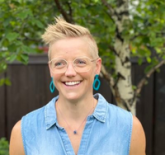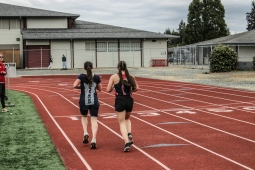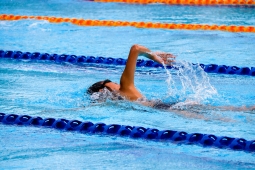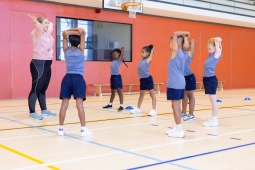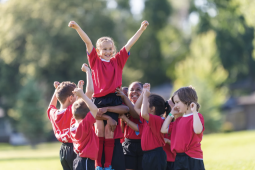Le rôle du mentorat dans la formation des enseignants d’éducation physique : le mentorat en pratique
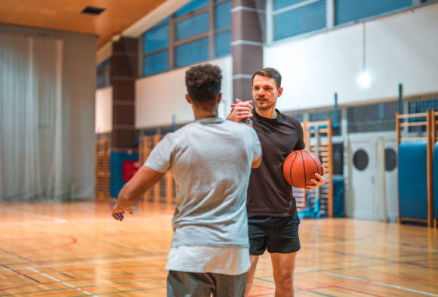
Publié précédemment dans le volume 81, numéro 3
This article is the second of a two-part series on mentoring in physical education and teacher education (PETE) programs. Part 1 was published in the PHE Journal on page 6 of Volume 81, issue 2 and can be accessed, here.
Part 2 will explore how mentoring can extend beyond coursework in a PETE program into internship, followed by the first years in the profession, and then span an entire career. Professional interactions between new graduates and alumni can become a powerful cycle of mentoring and may help encourage student teachers to “…take responsibility for their personal and social development” (Hellison, 2011, p. 14) while looking beyond themselves. This article also discusses a recent study that underlines how a supportive and collegial mentoring relationship during initial years of teaching may be one of the most influential factors of a positive experience while learning to teach (Funk, 2014). It also explores what a cycle of mentoring might look in practice.
Concept of mentoring
Anspal et al. (2012) identify that the primary concern for student teachers during a teacher education program and into the first years of teaching focuses mainly on the self. For example, they may want to confirm and validate their image of self as a teacher, which most likely will have already been formed long before the program, rooted in their own schooling experiences. Lortie (1975) emphasizes how influential socialization in the workplace can be, including the process by which we learn and maintain values deemed ideal for teaching. A mentor can act as a sounding board, can provide guidance, assist in supporting beginning teachers to learn and implement curricula, and can help with non-teaching related issues that beginning teachers may face in the transition to the workplace. Beauchamp and Thomas (2009) suggest reflection “… is recognized as a key means by which teachers can become more in tune with their sense of self and with a deep understanding of how this self fits into a larger context which involves others; in other words, reflection is a factor in the shaping of identity” (p. 182).
Mentoring involves a “…shared intellectual, ideological, political, personal, and emotional journey” (Chawla & Rawlins, 2004, p. 964) that can be beneficial for both the protégés and mentors. Mentoring can challenge the ‘norm’ of isolation so often prevalent in the teaching profession, where teachers are hesitant to ask for help with problems in their classroom/gymnasiums and feel uncomfortable engaging in constructive conversations. Mentoring has the potential to help break these barriers, especially during the internship experience and early years of teaching.
Becoming a mentor
The reasons for becoming a mentor are many, but one of the main reasons that experienced teachers cite as their motivation is that they were once mentored and found the benefits to be invaluable. In some cases, teachers might have had a less than ideal experience during their transition into the workplace and might want to change the process so that student teachers or beginning teachers do not replicate their experience. Others may welcome the challenge and satisfaction of ‘giving back’ or helping a young professional develop (Posden & Denmark, 2007). It also further reflects a professional understanding of social responsibility (Hellison, 2011). Although accepting the responsibility of becoming a mentor is not always an easy decision – student teachers require time, energy, attention, and emotional support – the benefits are familiar and well known to many experienced teachers who continue to take on the challenge. Mentoring that is built upon a foundation of fostering psychosocial and professional development (Griffin & Ayers, 2005) has the potential of resulting in a successful relationship.
Further, mentoring in the teaching profession “… may reduce the early attrition of beginning teachers” (Odell & Ferraro, 1992, p. 200) especially in the first years of their teaching experience, which are the most influential on a teacher’s decision to remain in the profession. By implementing an intentional cycle of mentoring both in the teacher education program and beyond the program (Figure 1), the HOPE program has attempted to embody Hellison’s (2011) model of teaching for personal and social responsibility (TPSR) (Table 1) and Rikard and Banville’s (2010) phases of mentoring (initiation, cultivation, separation, and redefinition).
Mentoring beyond the HOPE program
It is believed that the theoretical foundation and framework combined with the practical involvement of student teachers in the HOPE Program developmental initiatives (Touchstone, Coaching Program, Mentoring Program and Practical Experience-Internships – see Figure 1 Part A) provides the understanding of and the context for Mentoring. It is further believed that graduates of the HOPE program (alumni) who are now teachers in the field, recognize the opportunity and more importantly, the responsibility to become cooperating teachers and assume this critically important mentorship role. Over the duration of the PETE program each of these developmental initiatives nurtures and reflects the principles associated with teaching for personal and social responsibility as it relates to becoming a teacher and in essence, embodies what the HOPE program is founded upon. This in turn transfers to one’s life as a cooperating teacher whereby the concept of being a mentor now takes on a greater understanding and deeper meaning. It further represents how TPSR comes ‘full circle’ (Figure 1, Part B). However, taking on this important mentorship role demands that cooperating teachers are also supported through this process. Just as pre-service teachers need preparation, mentors need preparation (Feiman-Nemser, 1993; Huling & Austin, 1992; Mawer, 1996). In-services and orientations to the mentoring process are helpful, especially if a mentor teacher has not taken on this role before.
Teacher Education programs that promote the mentorship model described above should make every opportunity to provide internship seminars designed to foster the collegial relationship entered into by a cooperating teacher and intern during practicum experiences. The nature of these types of seminars should focus on building effective collegial working relationships between the cooperating teacher (mentor) and the student teacher (protégé). An intensive, developmental seminar (University of Regina, 2014) designed to allow the cooperating– intern pair to come to understand each other can serve to provide a solid foundation for the internship experience. It also provides an opportunity to highlight the purpose, goals, expectations, assessment and evaluation practices and establish an Internship Contract associated with the internship experience. This process aligns with the HOPE program expectations which students have lived in the first three years.
Internship seminars should be designed whereby the co-operating teacher and intern pair work collegially in a small group with three other pairs over an extended period of time in an environment removed from the school. This type of internship seminar should also include pairs of professional colleagues from various educational partners (retired teachers, principals, faculty members, teacher federation colleagues, school board members, etc.) working as facilitators for these small groups. This process has great potential for developing a strong, professional relationship between the pair as the members of the respective small groups can also act as professional support for the co-operating teacher and intern pair.
Although most mentoring relationships involving an intern and cooperating teacher only include two people, other professionals within the school environment may take part: teachers other that the intern may instruct alongside the principal of the school, a department head(s), and even possibly the director or superintendent of the school division. In addition, there is also the need for a faculty advisor who assumes a critically important role with the intern-cooperating teacher pair. Their role should be one that observes and nurtures the professional development of the intern, supports the cooperating teacher regarding the professional development of the intern as well as, act as liaison between the university and the school. Together, these three individuals (intern, cooperating teacher and faculty advisor), maintain a focus on professional development and reflect a model of mentorship that epitomizes a shared responsibility. In conclusion, it is implicit that the HOPE program has already provided a purposeful immersion into the shared responsibility.
Examples from the classroom/gymnasium:
Two student teachers’ experiences and the mentoring relationships with their cooperating teachers will be used as examples below. These experiences are from a recent study of physical education student teachers during their 16-week internship placement showed that a supportive, professional, and collegial mentoring relationship has the potential to be one of the most influential aspects of learning to teach (Funk, 2014). Not all professional relationships will be positive or constructive, but the support of one colleague may be enough to make a very large difference in a student teacher’s outlook.
Example 1: Ali
Ali was a physical education student teacher who completed her internship placement at a large secondary urban school. She worked with three cooperating teachers in physical education and social studies. Her primary cooperating teacher was a young female teacher (Kelsey) of six years experience who accompanied Ali to the internship seminar. She also worked alongside a female teacher (Krista), who had more than 20 years of experience, whom she also knew from playing softball in the community. About half way through the internship, when talking about some of the challenges she faced, Ali said, …”Kelsey and I are super comfortable and can talk about absolutely everything, but Krista I just feel is super judgmental and so strict that I got all worked up” (transcribed from group conversation, October 2, 2012). She seemed to have two very different relationships with each of the cooperating teachers, which may be attributed to Kelsey and Ali’s initial collegial relationship building experience at the internship seminar.
Ali had daily conversations with Kelsey about how things were going in the classes they taught together. For example, Ali explained that she felt she was struggling with a class of grade nine girls in the classroom but not in the gymnasium, and how nervous this made her feel. She said, “I’m not an assertive person. Me and Kelsey talked about maybe that’s why I can’t settle them in the classroom. Because I’m not assertive in the gym and then they come to the classroom and it’s magnified in that small space” (text message, Oct 22, 2012). Although she felt nervous and concerned, Ali and Kelsey were able to productively discuss the situation and some of the ways Ali may be able to find solutions. Through conversation and continual support alongside Kelsey, Ali was able to find success in what was initially a challenge for her.
Meanwhile, Ali worked alongside Krista as a cooperating teacher as well. They had not attended the internship seminar together at the start of the semester and, therefore, had not had the opportunity to discuss expectations and professional philosophies.
Ali’s frustrations with Krista stemmed from what she perceived as her inability to be ‘the real teacher’. In her words, she said, “… she won’t give up her class to me fully either… maybe she feels like she has to be like that, if she doesn’t trust me yet?” (transcribed from group conversation, October 2, 2012). In an example, Ali said, “Normally, she would yell, ‘Ali!’ and then I’d have to stop what I am doing and go over to her” (transcribed from group conversation, December 6, 2012). She described approaching Krista with her concerns as “…just so intimidating” (text message, November 21, 2012) yet said, “I think I need more confidence, definitely” (transcribed from group conversation, October 2, 2012). Ali did not think their relationship was entirely negative, yet was not sure how to approach her concerns with Krista. Perhaps these tensions would have been avoided if they initially had engaged in dialogue about conflict resolution, a topic of focus during the internship seminar.
Throughout her internship Ali said she struggled with managing and understanding two different philosophies of mentoring and felt that she had, in fact, gained a lot from both Krista and Kelsey; she recognized the time and energy she received from each. She was hesitant “…to always tell Kelsey because she has her own stuff to deal with … so she is busy too” (text message, November 21, 2012) and felt a different kind of support from Krista and explained their relationship as, “maybe I just take things more personally than some people… I guess she just gets in her zone and is passionate about teaching” (text message, November 21, 2012). Ali experienced two very different styles of support and mentoring and although one style was not as productive as it perhaps could have been, she managed to navigate the internship experience in a positive way with the support of one teacher who resonated with her. Most importantly, Ali felt like she had someone she could turn to if she needed, and someone she could have professional and constructive conversations about teaching with. This epitomizes the process of mentoring.
Example 2: Lauren
Lauren was a physical education student teacher who completed her 16-week internship at a large urban secondary school and also worked with a number of cooperating teachers. Primarily she worked alongside a physical education teacher (Janay) with 13 years experience who was in a position of leadership within the school. Janay and Lauren attended the internship seminar together in August before school began.
Lauren had been very anxious before the semester began about her potential relationship with Janay. She described their initial June meeting (student teachers are required to visit their schools and cooperating teachers at the end of the previous school year) and said, “I was just like, so quiet …I was actually really nervous because I’m kind of nervous even when meeting or making new friends. I like to just get a feel for people. I’m so shy” (transcribed from group conversation, August 9, 2014). She expressed that after attending the internship seminar together they had been able to discuss many important aspects and potential conflicts that they might face together, which provided a foundation for their internship pairing.
While giving a tour of her office space, Lauren seemed pleased about having a desk beside Janay’s. She explained, “This one is mine (pointing to desk on left) and that one is Janay’s desk (pointing to desk on right)” (Written from school visit notes, September 21, 2012). Lauren expressed how convenient it was that their desks were so close, so she could ask questions and solicit feedback. The close proximity allowed their professional relationship to grow and develop through dialogue and communication.
As the semester continued, Lauren’s confidence at school grew. She reflected on her earlier teaching and said that, “I also think that because I was really nervous at the start. That helped. I seem to come across as more confident when I am more nervous. So I guess the students thought I was confident and strict. It worked out. When I’m nervous I am louder and clearer. More specific” (transcribed from group conversation, October 2, 2012). Lauren’s comments reflect what Hellison (2011) might refer to as ‘firm but fair’. She continued to receive support from Janay even though Janay was busy and often not in their office at the same time as Lauren. Lauren said, “I get along great with Janay. Similar teaching styles, similar outlooks on assessment… We talk about a lot” (transcribed from recorded school visit conversations, December 11, 2012). The two made an effort to find time to talk, which had a large impact on Lauren’s confidence and teaching philosophy.
Lauren excelled during her internship because of the support she received from her cooperating teacher. She explained, “I am just lucky that I’ve had people around to support me.” (transcribed from group conversation, November 14, 2012). Even though Janay was busy with semi-administrative responsibilities, Lauren still felt that she made time for conversations about her teaching and aspects of her life outside of school; this support was crucial during a critical time in Lauren’s teaching career. Similar to Ali, this epitomizes the essence of mentoring.
Reflections on mentoring
As evident in the cases of Ali and Lauren, mentoring can be the support necessary for student teachers to successfully navigate the complex world of teaching. In addition, support for cooperating teachers throughout the internship is vital, as explained earlier. By looking at a model used by the HOPE program, we can see that intentionally implementing a cycle of mentorship from the first year of a program through internship, into a career and then ‘giving back’ as a cooperating teacher is a very effective approach.
However, not all mentoring is positive and it should not be portrayed as an unqualified good (Bullough & Draper, 2004; Gratch, 1998, Mawer, 1996). Teachers who are good at teaching children may not necessarily be good at teaching teachers. Gratch (1998) argues that, “… the presence of mentors does not in and of itself guarantee that teachers will become more skilled at teaching or more thoughtful about their work than they would be without mentors” (p. 221). For a teacher to adopt new and reflexive practices, s/he must also be ready and willing to put forth the effort (Shulman, 2004) and also be open to their own learning. We may ask ourselves, as teachers and teacher educators, how we can support student teachers and beginning teachers in positive, productive ways. Perhaps part of the answer lies in the possibility that PETE Programs that are founded upon principles associated with TPSR (Table 2) and nurture initiatives that embody mentoring encourage this to be transferred and sustained in the lives of graduates who then become practicing teachers (Figure 1, Part A and B).
It is also interesting to note that in both Ali and Lauren’s stories, their primary cooperating teacher were HOPE Alumni and also accompanied them to the internship seminar prior to the start of the school semester. It was with these teachers that positive mentoring relationships emerged. This positive mentoring relationship was then transferred back to the HOPE Mentoring Program when Ali and Lauren returned as 4th year post-intern students and assumed the responsibility for mentoring in the HOPE Mentoring Program. Their personal and professional skill sets regarding the mentoring process through internship were developed even further and their ability to mentor within the HOPE Program took on deeper meaning with 3rd year pre-interns.
Concluding thoughts
This article, Part II in a series, explored how mentoring can extend beyond a teacher education program into a career (Table 1, Part B) as graduates of the HOPE program become first year teachers and eventually cooperating teachers working with HOPE students during internship. A sense of ownership and involvement in a larger community of physical education teachers highlights Hellison’s (2011) TPSR model and supports not only students and interns but also beginning and experienced teachers as well.
References
Anspal, T., Eisenschmidt, E., & Lofstrom, E. (2012). Finding myself as a teacher: Exploring the shaping of teacher identities through student teachers’ narratives. Teachers and Teaching: theory and practice. 18:2. 197-216.
Beauchamp, C. & Thomas, L. (2009). Understanding teacher identity: An overview of issues in the literature and implications for teacher education. Cambridge Journal of Education, 39:2. 175-189.
Bullough, R.V. & Draper, R. J. (2004). Making sense of a failed triad: Mentors, university supervisors, and positioning theory. Journal of Teacher Education, 55:5. 407-420.
Chawla, D. & Rawlins, W. (2004). Enabling reflexivity in a mentoring relationship. Qualitative Inquiry, 10:6. 963-978.
Feiman-Nemser, S. (1993). Teacher mentoring: A critical review. ERIC Clearinghouse on Teaching and Teacher Education <http://www.eric.org/95-2.html>.
Funk, S.D. (2014). Living a curriculum of tensions: Experiences of learning to teach physical education (Doctoral dissertation). University of Regina, Regina, Saskatchewan.
Gratch, A. (1998). Beginning teacher and mentor relationships. Journal of Teacher Education, 49:3. 220-227.
Griffin, L.L. & Ayers, S.F. (2005). Chapter 1: Introduction – the roles and process of mentoring. Journal of Teaching in Physical Education, 24. 297-301.
Hellison, D. (2011). Teaching personal and social responsibility through physical activity (3rd Ed.). Human Kinetics, Inc: USA.
Huling-Austin, L. (1992). Research on learning to teach: Implications for teacher induction and mentoring programs. Journal of Teacher Education, 43:3. 173-180.
Kell, S. & Forsberg, N. (2014). The role of mentoring in physical education teacher education: A theoretical and practical perspective. Physical and Health Education Journal, 80:2, 6-11.
Lortie, D. C. (1975). Schoolteacher: A sociological study. Chicago, IL: University of Chicago Press.
Mawer, M. (1996). Mentoring in Physical Education: Issues and Insights. Taylor & Francis. Retrieved 8 May 2012, from <http://lib.myilibrary.com.libproxy.uregina.ca:2048?ID=31721>
Odell, S. J. & Ferraro, D. P. (1992). Teacher mentoring and teacher retention. Journal of Teacher Education, 43:3. 200-204.
Posden, I. & Denmark, V. (2007). From masterful teacher to masterful mentor. In I. Posden & V.Denmark, Coaching and Mentoring First-Year and Student Teachers, 2nd Ed. (pp. 912). Larchmont, N.Y.: Eye On Education, Inc.
Rikard, G.L. & Banville, D. (2010). Effective mentoring: Critical to the professional development of first year physical educators. Journal of Teaching in Physical Education, 29. 245-261.
Shulman, J. H. (2004). From inspired vision to impossible dream: The dangers of imbalanced mentoring. Journal of Teacher Education, 55:5. 393-406.
Stanulis, R.N. & Floden, R.E. (2009). Intensive mentoring as a way to help beginning teachers develop balanced instruction. Journal of Teacher Education, 60:2. 112-122.
University of Regina (2014). Learning to teach: A shared responsibility. Retrieved from http://www.uregina.ca/education/assets/docs/pdf/pdfe/InternshipManual-May4-2015.pdf

